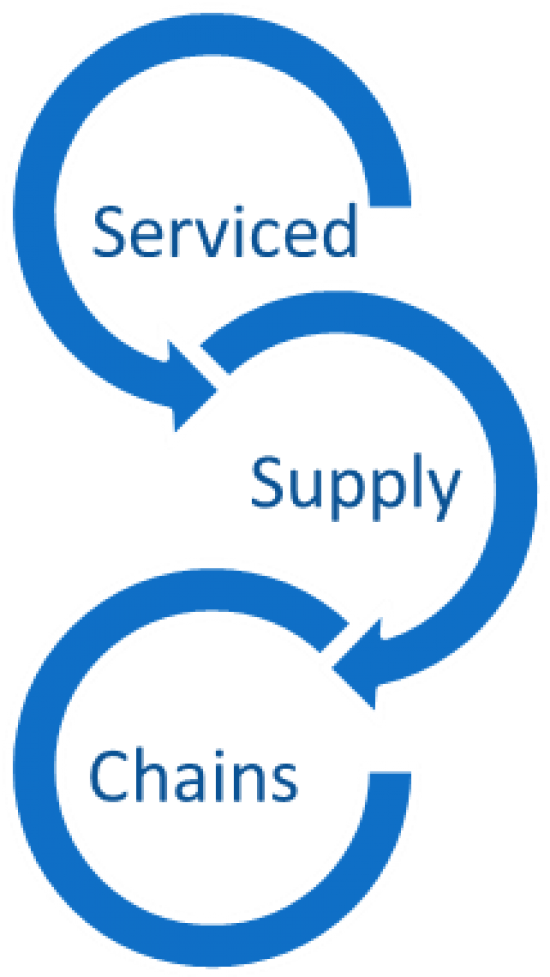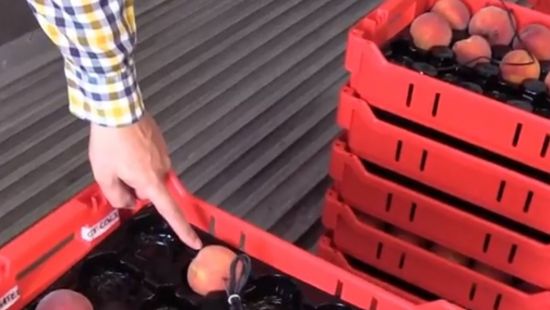Monitoring and modelling to improve the quality of Australian fresh produce into Asian markets.

The Serviced Supply Chain (SSC) project aims to increase the value and profitability of Australian horticultural exports by improving the ‘freshness, consistency and reputation' of Australia’s horticulture exports into Asia.
In Victoria, this project works with the summerfruit and table grape export chains to demonstrate the benefits of supply chain monitoring and use of predictive tools for improvements in export fruit quality and cold chain management in transit to Asian export markets and their domestic supply chains.
On this page:

- Monitoring to Improve – sensors and interventions to improve key transport and holding conditions
- Decision Aid (Predictive) Tools – implement and maximise outturn quality
- Sustainable Solutions – awareness and adoption in the horticulture industry including demonstrating benefit/cost
About the Serviced Supply Chain Decision Aid Tools
The project uses monitoring systems to gather information on fruit quality changes and shelf life capacity as well as in-transit cold disinfestation outcomes.
Data modelling will develop prediction tools and determine appropriate monitoring technologies and systems. The models and emerging technology will ensure exporters make confident marketing decisions based on sound science and help optimise the use of sea freight export by minimising risk.
Stonefruit: harvest/post-harvest research on the Profitable Stonefruit Network
Press Modified Atmosphere Packaging
Press Fruit position & orchard location: fruit quality & storage disorders
Press Preconditioning fruit to reduce storage disorders
Press Cultivar performance for export
Press Predicting impacts on fruit quality
Press Effect of air freight temperature on fruit quality
Press Stonefruit: Using remote data loggers to monitor temperatures
Press How to use monitoring technologies
Methylbromide quarantine treatment for peaches to China
 Methylbromide quarantine treatment research at Tatura, Agriculture Victoria
Methylbromide quarantine treatment research at Tatura, Agriculture Victoria
Fumigation protocol experiment
This stonefruit information and the fumigation protocol experiment are located in the Profitable Stonefruit network pages. These pages contain research investigating future production systems and export market preferences to improve productivity, quality and grower returns.
Table grapes harvest and post-harvest research
Press Real-time monitoring for sea-freight to Asia
Press Table grape rot risk assessments at harvest
Press Impacts on table grapes from delays between harvesting and cooling
Press Table grape cool storage performance
Press How to use monitoring technologies

This information is located in the Table Grape Research pages.
Resources
Resources from the Department of Agriculture and Fisheries - Queensland
Press Page contains video interviews and information sheets that may be of value to businesses interested in improving the management of their supply chain.
Stonefruit Research Roadshow August 2019
Presentation from Stonefruit Research Roadshow August 2019
Download PDF in new window. (Note: this document does not meet WCAG 2.0 accessibility guidelines)
- Predicting fruit quality and shelf life
- Simulated sea freight and quality prediction – Majestic Pearl
- Fruit quality issues – SSC and cool storage
- Air freight temperature vs flesh firmness (kgf)
- Stone fruit pre-conditioning – a solution?
- Preliminary cultivar recommendations – Extended storage
Introduction to the research
Video: Introduction to Stonefruit Simulation Research
Video transcript
As part of this project and focused on stonefruit, what we're looking at is a few areas. One is taking some of these import and export cultivars and looking at the storage potential. So simply storing them or simulating sea freight and import and storage in the importing country using the same temperatures that they would use in during export and looking at their performance, at the cultivars performance in terms of ripening, changes in flesh firmness and any physiological disorders like flesh browning that may occur. And we're looking at mainly white fleshed peaches and nectarines, some yellow nectarines as well as some plums. And this will provide industry with, or will give them some idea of how long these cultivars can be stored for before we see some problems coming up. So we do understand that there are some issues with some of these cultivars, but we're just confirming them by doing these storage trials. There's two other areas where we're sort of specifically looking at. One is what kind of post-harvest treatments we can apply to these cultivars to potentially reduce the severity of the physiological disorders. And also looking at what effect the current post-harvest treatments such as dis-infestation has on subsequent quality in export markets, so a sort of two pronged attack. And the final area we're looking at is to actually try to predict remaining shelf-life during export based on temperatures occurring during the export chain, and the duration of the export chain. And so we're hoping to develop a model that is cultivar specific, that you can plug in your export temperatures, time it's taking to get to importing markets, time that fruit is stored in the importing country, and the model will be able to tell you what the remaining shelf life is of that fruit.
What we found is because these cultivars seemed to be quite susceptible to chilling injury and flesh browning, that impacts on the predictive ability of the model that we will develop. So, we've taken a step back now and really considering which cultivars can be exported by sea freight and, if potentially there's going to be some quality issues with chilling injury, for example, then do we strictly stick to airfreight, which is obviously a much shorter timeframe?
Video: observations from research on cultivars, flesh disorders, harvest maturity, and predicting fruit firmness.
- a number of cultivars have limited cool storage potential
- simulations indicate risk of chilling injuries for these cultivars
Video transcript
So far, it's two and a half years into the project, and I guess the key story that's come out of the work we've been doing is that many of the cultivars we are exporting into Asian markets, particularly the white fleshed peaches and nectarines, seem to be under-performing in the sense that their storage potential is limited in terms of storage duration at low temperature, which is what is required for sea freight export. And sea freight export usually takes three to four weeks once it leaves Australia and gets to Asian markets. For example, China. And during that time, we're simulating that sea freight export and we're finding at the end of the sea freight leg that we're observing some physiological disorders commonly known as chilling injury. And the main symptom is flesh browning and loss of texture, So the loss of eating quality. It's quite a concerning because these cultivars have been planted out in quite high numbers, high volumes, and they are import and export cultivars. So I guess what our aim now is to determine what are the factors influencing the severity of these disorders. And that's within sort of a research sphere, but then there's the logistics of how does the industry shorten the export duration from harvest right through to the importing country? Because at the moment it's it's probably five to seven days from harvest to the freight forwarder, and then we're looking at probably four weeks sea freight durations, so you're already at five weeks storage, low temperature storage, but five weeks storage duration before it even gets the importing countries.
Introduction to the Serviced Supply Chain project - Table Grapes and Stonefruit (Lecture presentation - 2019)
Video presentation (Agribiosciences, Bundoora) - 11 minutes
John Lopresti, research scientist, introduces the serviced supply chain project: monitoring and modelling to improve the quality of Australian fresh produce into Asian markets.
The Science:
Predictive Tools - Science behind the Service Supply Chain project
Video presentation (Agribiosciences, Bundoora) - 9 minutes
John Lopresti, research scientist, discusses science behind the serviced supply chain project. (Part 1)
Predictive Tools (part 2) - Modelling tools & export simulations
Science behind the Service Supply Chain project
Video presentation (Agribiosciences, Bundoora) - 15 minutes
John Lopresti, research scientist, discusses science behind the serviced supply chain project. (Part 2)
Presentation by John Lopresti 14 July 2017 at Agribio, Agriculture Victoria
Download PDF in new window (Note: this document does not meet WCAG 2.0 accessibility guidelines)
Acknowledgements
The Serviced Supply Chains project is funded by the Hort Frontiers Asian markets Fund, part of the Hort Frontiers Asian strategic partnership initiative developed by Hort Innovation, with co-investment from Agriculture Victoria, the Department of Agriculture and Fisheries Queensland (DAFQ), Montague Fresh (summerfruit), Manbulloo (mangoes), Glen Grove (citrus), the Australian Government plus in-kind support from University of Queensland and the Chinese Academy of Sciences.
